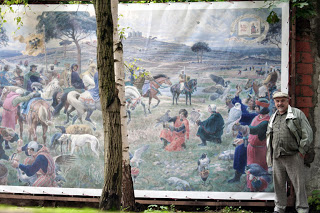Peculiar sends a link to the latest– there always seems to be news– on Emperor Frederic the Second (1194- 1250), of Sicily and the Holy Roman Empire (which wits will still tell you was none of the three)…
I have been trying unsuccessfully for years to sell a book on Frederic and his surviving relics like the amazing Castel del Monte (good book here). It might begin thus:
“Born a German Emperor in Sicily, to a mother nearly 50 years old; raised a street kid in Palermo, reclaimed his heritage at 16; feuded with popes, was excommunicated (often); made a reluctant crusade that ended in a mosque, shaking hands with Saladin and discussing falconry; died at 57 of malaria; left only an Italian Moslem town that survived him for less than a century, a son who was soon to die defending his cause and bloodline, a strange castle in Puglia , and a book of advanced science and art in the form of a hunting manual , The Art of Hunting with Birds.
“He was reputed in his lifetime to be the Antichrist, and was known as Stupor Mundi, the Wonder of the World. Dante, of the opposing political party, wrote him into Hell.
“The Nazis liked him for maintaining power as a northerner among Mediterraneans, despite his keeping a court of Jews, Moslems, and heretical troubadors, maintaining a beacon of rational tolerance in a time with little enough of that. Also despite the fact that his leading historian was the Jewish Ernst Kantorowicz, who they exiled (he ended up teaching at Berkeley).
“He defeated a Moslem guerilla army in Sicily , then made them into a kind of mercenary guard, settling them in the walled city of Lucera on the mainland and building them a mosque. He tempted St. Francis of Assisi with naked dancing girls. He was reputed to have experimented on humans, raising children without speaking to see what tongue they spoke, weighing bodies before and after death to attempt to discover the weight of the soul. As in his falconry manual, he was, perhaps to an excessive degree, the first anti – Aristotelian empiricist.
“When the opened his tomb not long ago they found he was sharing his tomb with an unknown young woman. Today he is remembered mostly by falconers, Sicilian patriots, and perhaps the Mafia, which some legends say started as a local patriotic society, fighting occupying forces and landlords in his memory.”
The in- print translation of his de Arte Venandi cum Avibus will be in my “book of books”. And Vadim Gorbatov has painted him, more than once.


